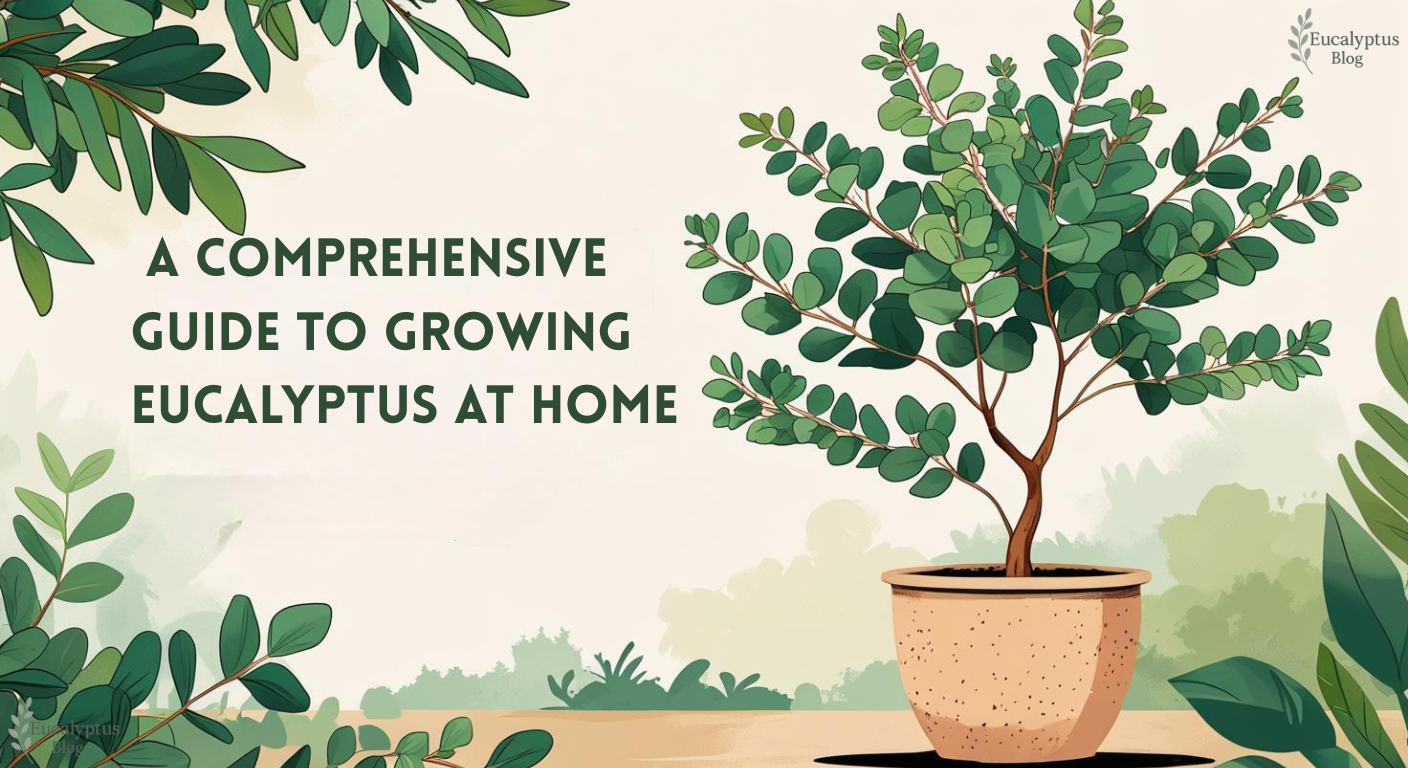A Comprehensive Guide to Growing Eucalyptus at Home
A Comprehensive Guide to Growing Eucalyptus at Home
.png)
Eucalyptus, with its aromatic leaves and striking appearance, is a stunning addition to any home or garden. Native to Australia, these trees and shrubs are loved for their versatility—whether you’re growing them for their beauty, scent, or even for small-scale essential oil production. While they’re often associated with sprawling landscapes, many eucalyptus varieties can thrive in pots or small spaces with the right care. Here’s your complete guide to growing eucalyptus at home, from choosing the right type to ensuring it flourishes.
Why Grow Eucalyptus?
Eucalyptus plants offer more than just good looks. Their leaves release a refreshing, minty aroma that can repel insects naturally. They’re also relatively low-maintenance once established and can be used in crafts, like wreaths, or for their therapeutic properties. Plus, growing your own eucalyptus means you’ll always have a fresh supply of leaves for home remedies or decor.
Step 1: Choose the Right Eucalyptus Variety
Not all eucalyptus plants are suited for home growing, as some can reach towering heights of over 100 feet. For smaller spaces, opt for compact or dwarf varieties:
- Eucalyptus gunnii (Cider Gum): A popular choice for home gardeners, it grows to about 30-40 feet but can be kept smaller with pruning. It has round, silver-blue leaves.
- Eucalyptus citriodora (Lemon Eucalyptus): Known for its lemony scent, this variety can be grown in pots and typically reaches 6-10 feet if pruned regularly.
- Eucalyptus pauciflora (Snow Gum): A smaller species, perfect for containers, growing to about 15-20 feet with beautiful white bark.
If you’re in a colder climate, check the hardiness of your chosen variety—most eucalyptus prefer USDA zones 8-11 but can survive in cooler areas with protection.
Step 2: Start with Seeds or a Young Plant
You can grow eucalyptus from seeds, but it’s a slow process. For faster results, start with a young plant from a nursery.
Growing from Seeds:
- Sow seeds in early spring on the surface of a well-draining seed-starting mix.
- Keep the soil moist and place the tray in a warm spot (around 70°F/21°C) with bright, indirect light.
- Germination can take 2-4 weeks. Once seedlings are 3-4 inches tall, transplant them into individual pots.
Starting with a Young Plant:
Look for a healthy plant with vibrant leaves and no signs of pests. Young plants adapt better to new environments than mature ones.
Step 3: Provide the Right Growing Conditions
Eucalyptus thrives in conditions that mimic its native Australian habitat—think sunny, warm, and well-drained.
Light:
- Eucalyptus loves full sun, so place it where it gets at least 6-8 hours of direct sunlight daily.
- If growing indoors, a south-facing window is ideal.
Soil:
- Use well-draining, slightly acidic soil (pH 6.0-7.0). A mix of potting soil, sand, and perlite works well.
- Avoid heavy, waterlogged soils, as eucalyptus roots are prone to rot.
Watering:
- Water regularly but sparingly—let the top inch of soil dry out between waterings.
- Once established, eucalyptus is drought-tolerant, so avoid overwatering.
Temperature and Humidity:
- Eucalyptus prefers warm temperatures (60-75°F/15-24°C) and low humidity.
- Protect it from frost if you’re in a colder region by bringing potted plants indoors or covering outdoor plants during winter.
Step 4: Planting and Potting
If you’re growing eucalyptus in a pot (recommended for most home gardeners), choose a container with drainage holes that’s at least 12-18 inches wide to accommodate root growth.
- Fill the pot with your well-draining soil mix.
- Plant the eucalyptus at the same depth it was in its nursery pot.
- Water thoroughly after planting and place in a sunny spot.
For outdoor planting, ensure the location has enough space for growth and isn’t prone to water pooling.
Step 5: Care and Maintenance
Eucalyptus is relatively easy to care for, but a few tips will keep it thriving:
Pruning:
- Prune regularly to control size and encourage bushy growth. Early spring is the best time.
- For a shrub-like appearance, cut back the main stem to 6 inches every 1-2 years (a technique called coppicing).
Fertilizing:
- Feed with a balanced, slow-release fertilizer (like 10-10-10) once in spring and once in summer.
- Avoid over-fertilizing, as eucalyptus doesn’t need much.
Pest and Disease Control:
- Watch for pests like aphids or spider mites. A gentle spray of neem oil can help.
- Root rot is a common issue if overwatered—ensure proper drainage to prevent this.
Step 6: Harvesting and Using Eucalyptus
Once your plant is established (usually after a year), you can start harvesting leaves. Cut small branches with clean shears, leaving enough for the plant to continue growing. Use fresh leaves for:
- Aromatherapy: Add to a diffuser with water for a refreshing scent.
- Decor: Dry the leaves and use them in wreaths or bouquets.
- Home Remedies: Steep leaves in hot water for a soothing steam inhalation.
Common Challenges and Solutions
- Yellowing Leaves: Often a sign of overwatering or poor drainage. Adjust your watering schedule and check the soil.
- Slow Growth: Ensure the plant is getting enough sunlight and nutrients.
- Frost Damage: If leaves turn brown after a cold snap, prune damaged parts and protect the plant moving forward.
Conclusion
Growing eucalyptus at home is a rewarding journey that brings a touch of nature’s magic to your space. With the right variety, a sunny spot, and some basic care, you’ll have a thriving plant that offers beauty, fragrance, and practical uses. Start small, be patient, and soon you’ll be enjoying the benefits of your very own eucalyptus!
.png)
.png)
.png)
Comments
Post a Comment